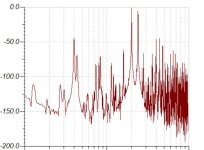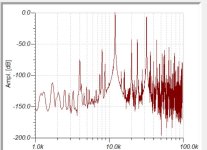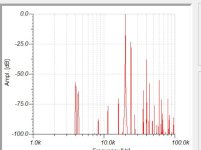H
HAYK
The raw DAC output has image frequencies above the audible range. I read the necessity of reconstruction filter so that:
1) The tweeter doesn't get needless frequencies and get its maximum power limit reach prematurely.
2) The intermodulation caused by nonlinearty of the amplifier and the speaker can generate audible frequencies which makes it sound harsh.
I see from graphs, -50db is applied in the non audible range, how much is minimum acceptable?
1) The tweeter doesn't get needless frequencies and get its maximum power limit reach prematurely.
2) The intermodulation caused by nonlinearty of the amplifier and the speaker can generate audible frequencies which makes it sound harsh.
I see from graphs, -50db is applied in the non audible range, how much is minimum acceptable?
It depends. Are we talking about CDs without oversampling? And you want flat response up to 20kHz? Its a not-insignificant problem to solve ideally, which is why 48kHz would have been a much more reasonable sample rate.
I recall Bruno Putzeys pointing out in one of his AES masterclasses that unfiltered NOS doesn't give consistent group delay. But I don't recall him quantifying how much image rejection corresponds to how much group delay variation.
See pp56-59 in this document : https://www.hypex.nl/media/ed/cf/4a/1682341903/The engineers survival guide.pdf
See pp56-59 in this document : https://www.hypex.nl/media/ed/cf/4a/1682341903/The engineers survival guide.pdf
H
HAYK
On LTSPICE I get -5db image of 20khz at 24khz.
-9db for 16khz at 28khz, -10db for 12khz at 32khz.
If I pass these ratios through a common emitter 2n2222a amp with 1% distortion simulating an amp+tweeter character, I get an intermodulation of 4khz for 20khz about -45db and about the same at 20khz for 12khz signal.
This is less than 1%.
-9db for 16khz at 28khz, -10db for 12khz at 32khz.
If I pass these ratios through a common emitter 2n2222a amp with 1% distortion simulating an amp+tweeter character, I get an intermodulation of 4khz for 20khz about -45db and about the same at 20khz for 12khz signal.
This is less than 1%.
Attachments
H
HAYK
If I filter only -20db the image, I get less than -60db 4khz. Why such level is not sufficient?
For mutitone for example 8khz and 12khz, the images are 36k and 32khz. The tweeter has already attenuated these frequencies to generate 4khz beat but not the amp that can distort 1% at these frequencies. The level of the images are -16db a d -10db. The 4khz than is -55db without filter.
For mutitone for example 8khz and 12khz, the images are 36k and 32khz. The tweeter has already attenuated these frequencies to generate 4khz beat but not the amp that can distort 1% at these frequencies. The level of the images are -16db a d -10db. The 4khz than is -55db without filter.
Attachments
Each of us has to decide for ourselves how much degradation by images is 'sufficient'. For me, I'm not sure I notice any change in going from 9th to 11th order Chebyshev low-pass for anti-imaging.
H
HAYK
The image troubles are for 12k_20khz. These frequencies in music are what spices in food. They can be perceived on transients. I think it is better to filter low pass the DAC at 12khz in Bessel and treat the higher frequencies separately to get rid of their images and add back to the low passed. By this,level adjustments can be applied independently.
If you apply too high attenuation in the stop band, than the transients are much slower and the sound looses crisp. This why the attenuation should be the minimum acceptable to keep as fast as possible these spicing transients.
Another problem with high stop band attenuation is the resonance. OK, the image in steady signal is attenuated but it will leave a trail of resonant on start and stop which in turn create audible frequencies. Here too needs to compromise.
If you apply too high attenuation in the stop band, than the transients are much slower and the sound looses crisp. This why the attenuation should be the minimum acceptable to keep as fast as possible these spicing transients.
Another problem with high stop band attenuation is the resonance. OK, the image in steady signal is attenuated but it will leave a trail of resonant on start and stop which in turn create audible frequencies. Here too needs to compromise.
Last edited by a moderator:
I have done some measurements which are relevant to your discussion.
Start here https://www.diyaudio.com/community/threads/nos-oversampling-and-now-hybrid.366298/post-7558827
The meat is at posts # 52, 53
George
Start here https://www.diyaudio.com/community/threads/nos-oversampling-and-now-hybrid.366298/post-7558827
The meat is at posts # 52, 53
George
H
HAYK
I am wondering why in off you are getting 4khz -15db and 6 kHz beat? Where in your measuring equipment intermodulating so hard ? What good to see the digital is not cleaner in audio band as the passive. It has 1khz at -40db.

There are people who only use a zero-order hold as reconstruction filter, and apparently most of them don't see their tweeters go up in flames. Most audiophile non-oversampling DACs are of this type. It causes more than 3 dB of drop at 20 kHz when you listen to 44.1 kHz sample rate recordings, and when you have domestic pets who can hear well above 22.05 kHz, it's a form of animal abuse, as they have to listen to the unsuppressed images.
- Home
- Source & Line
- Digital Line Level
- Reconstruction filter: how much attenuation is the minimum?


